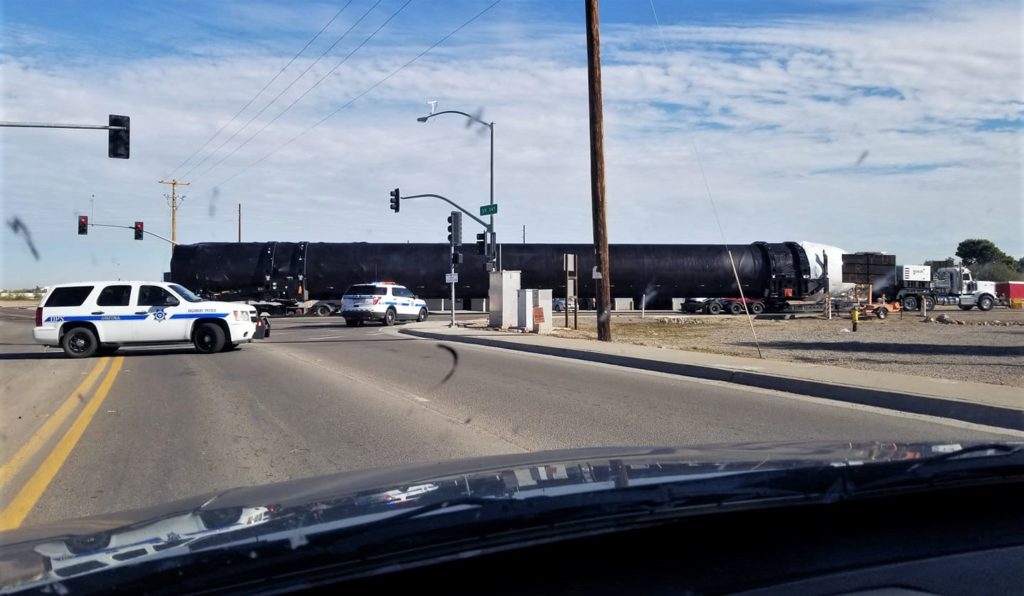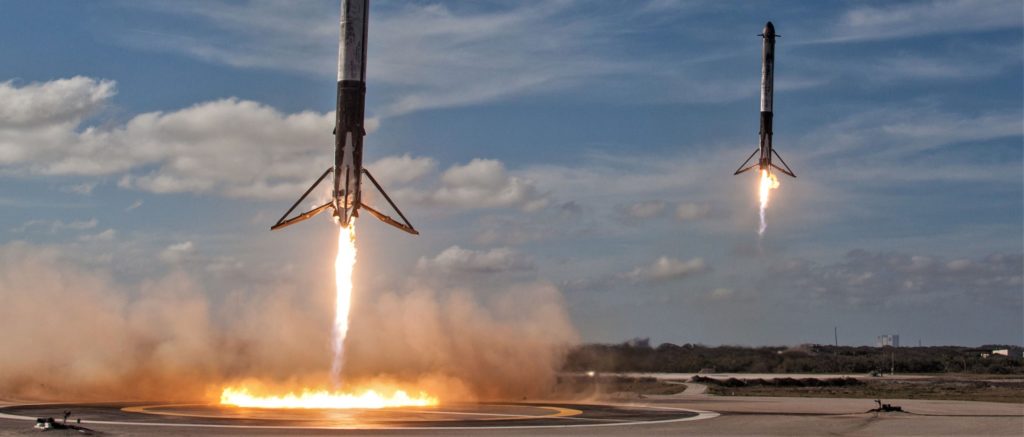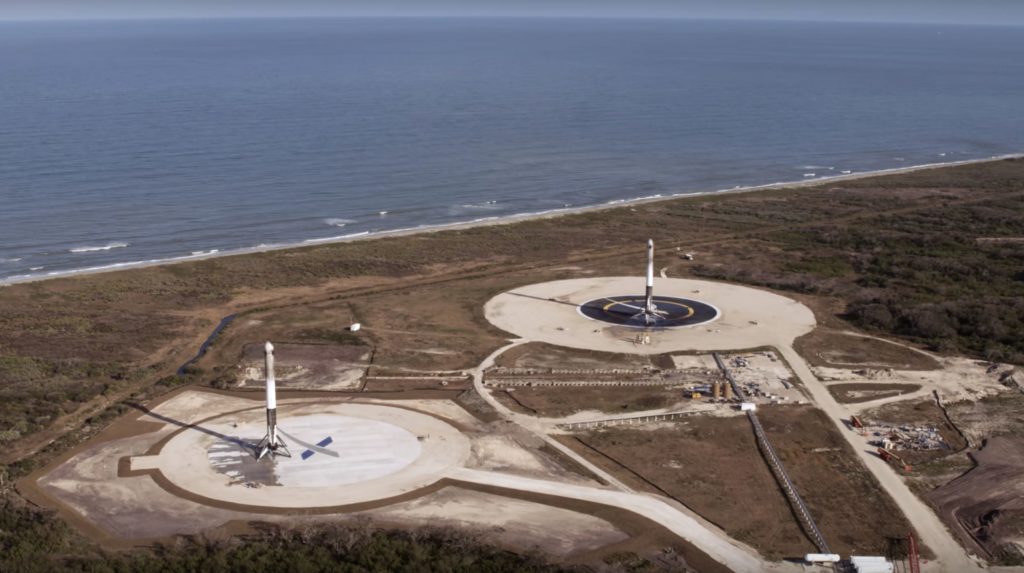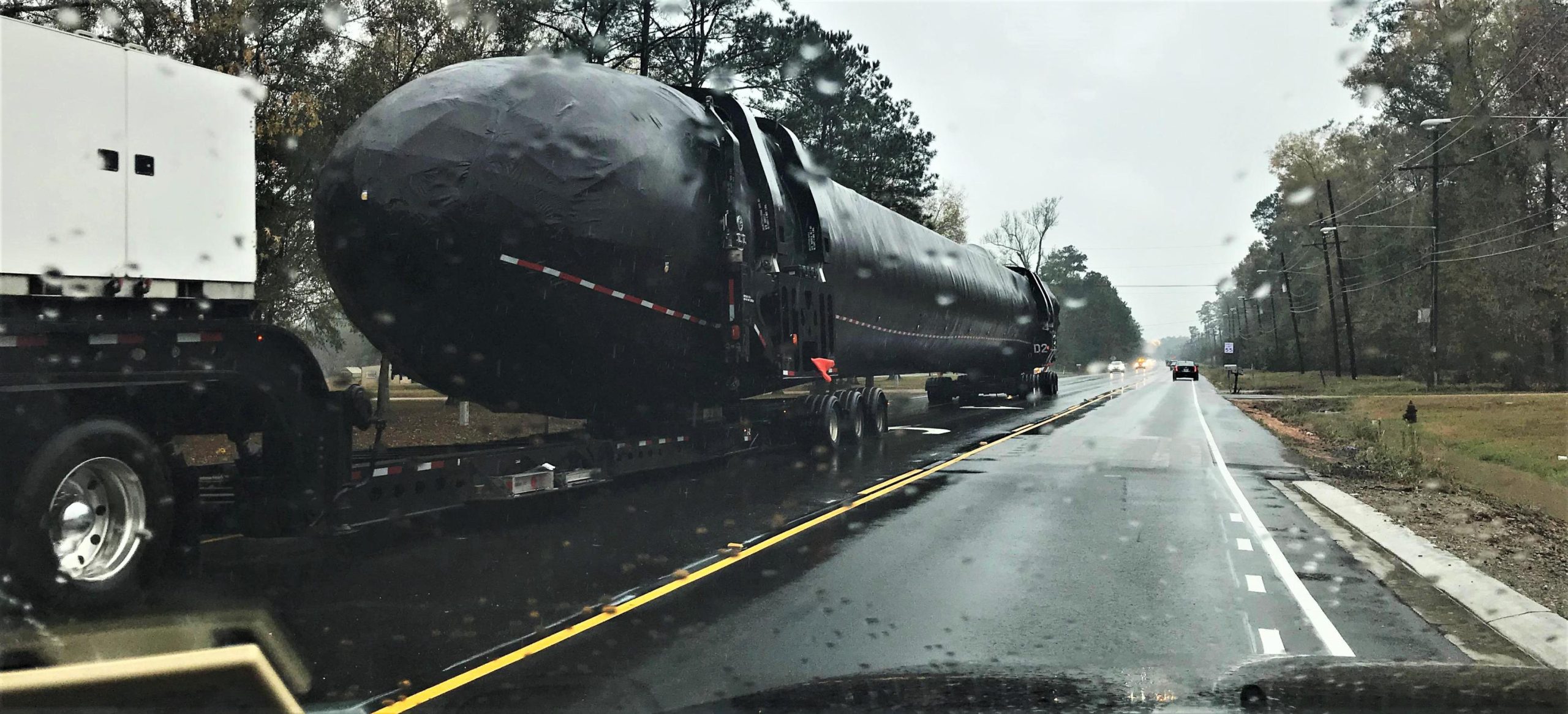
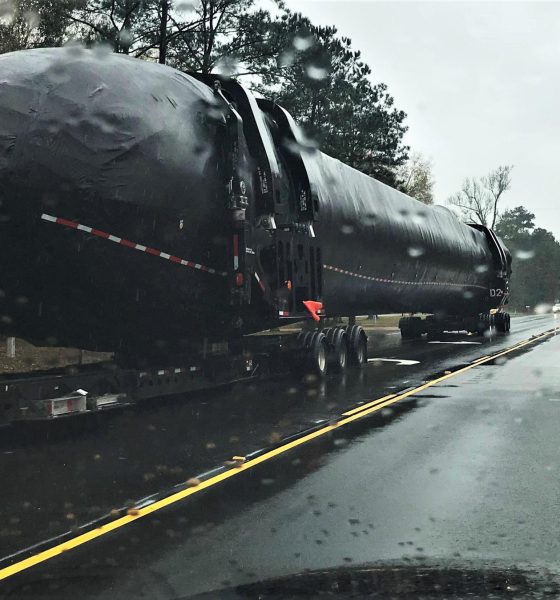
News
SpaceX to attempt back-to-back Falcon Heavy launches with booster reuse in 2019
SpaceNews reports that SpaceX is planning an impressive duo of Falcon Heavy launches in the first half of 2019, the heavy lift rocket’s second and third missions. According to Nicky Fox, NASA’s heliophysics division director, SpaceX intends to recover and reuse all three Falcon Heavy first stage boosters for both launches and apparently believes that it can recover and prepare them for a second launch in as few as 60 days.
Following a highly successful February 2018 launch debut, SpaceX has targeted the launches of commercial satellite Arabsat 6A and the USAF’s Space Test Program 2 (STP-2) in the second half of 2018, a schedule that rapidly realigned to H1 2019. If the unofficial plan described above turns out to be true, the USAF will apparently become the first commercial customer to launch on a flight-proven Falcon Heavy.
NASA looking to launch delayed space science missions in early 2019 https://t.co/Q3wojAStr5 pic.twitter.com/YBp4lhF1bo
— SpaceNews (@SpaceNews_Inc) December 19, 2018
A Reddit user was lucky enough to spot one of SpaceX’s next-gen Falcon Heavy side boosters – coincidentally just one day after Dr. Fox’s comments – on its way East through rainy Louisiana, undeniable evidence that the heavy lift rocket’s second (and third) launches have a real chance of happening in early 2019. According to Dr. Fox, SpaceX is seriously targeting a very rapid turnaround of Falcon Heavy’s next three first stage boosters, stating (admittedly without official confirmation) that SpaceX would be reusing the boosters from Arabsat 6A’s March 2019 launch on the planned April 2019 launch of STP-2.
“[Falcon Heavy] will launch [STP-2 in April] after the successful launch of Arabsat, which is currently manifested for March. [SpaceX] will recover and reuse the boosters, so we’re kind of watching what happens with that first launch.” – Dr. Nicky Fox via SpaceNews
Whether or not this officially unconfirmed information is correct, it certainly sounds like just the thing that CEO Elon Musk might challenge SpaceX to pull off, not to mention the fact that this would place the US Air Force in a situation requiring it to become the first commercial customer to launch on a flight-proven Falcon Heavy. This would be a truly dramatic change in attitude compared to comments made in just the last week, brought up in the context of SpaceX’s planned December 18 (now Dec 22) launch of the USAF’s first next-gen GPS satellite, GPS III SV01. In official comments provided to the media, the Air Force was extremely “uncertain” about allowing SpaceX to even attempt to recover its Falcon 9 booster, let alone allowing the company to fly Air Force payloads on flight-proven rockets.
- The second Falcon Heavy booster in four weeks was spotted Eastbound in Arizona by SpaceX Facebook group member Eric Schmidt on Dec. 3. (Eric Schmidt – Facebook)
- Falcon Heavy’s two side boosters landed side-by-side after a successful launch debut. (SpaceX)
- LZ-1 and LZ-2, circa February 2018. (SpaceX)
- Falcon Heavy ahead of its inaugural launch. (SpaceX)
Admittedly, the intentions behind STP-2 differ drastically from GPS III SV01. As the name suggests, the missions falls under a program explicitly designed to test and prove out new launch vehicles in the context of fast-tracking their certification for higher-value Air Force spacecraft. Falcon 9 could almost certainly launch STP-2 in a reusable configuration, but the USAF chose Falcon Heavy – and included literal dead weight – because the military branch is very interested in the rocket’s potential utility for more serious National Security Space missions.
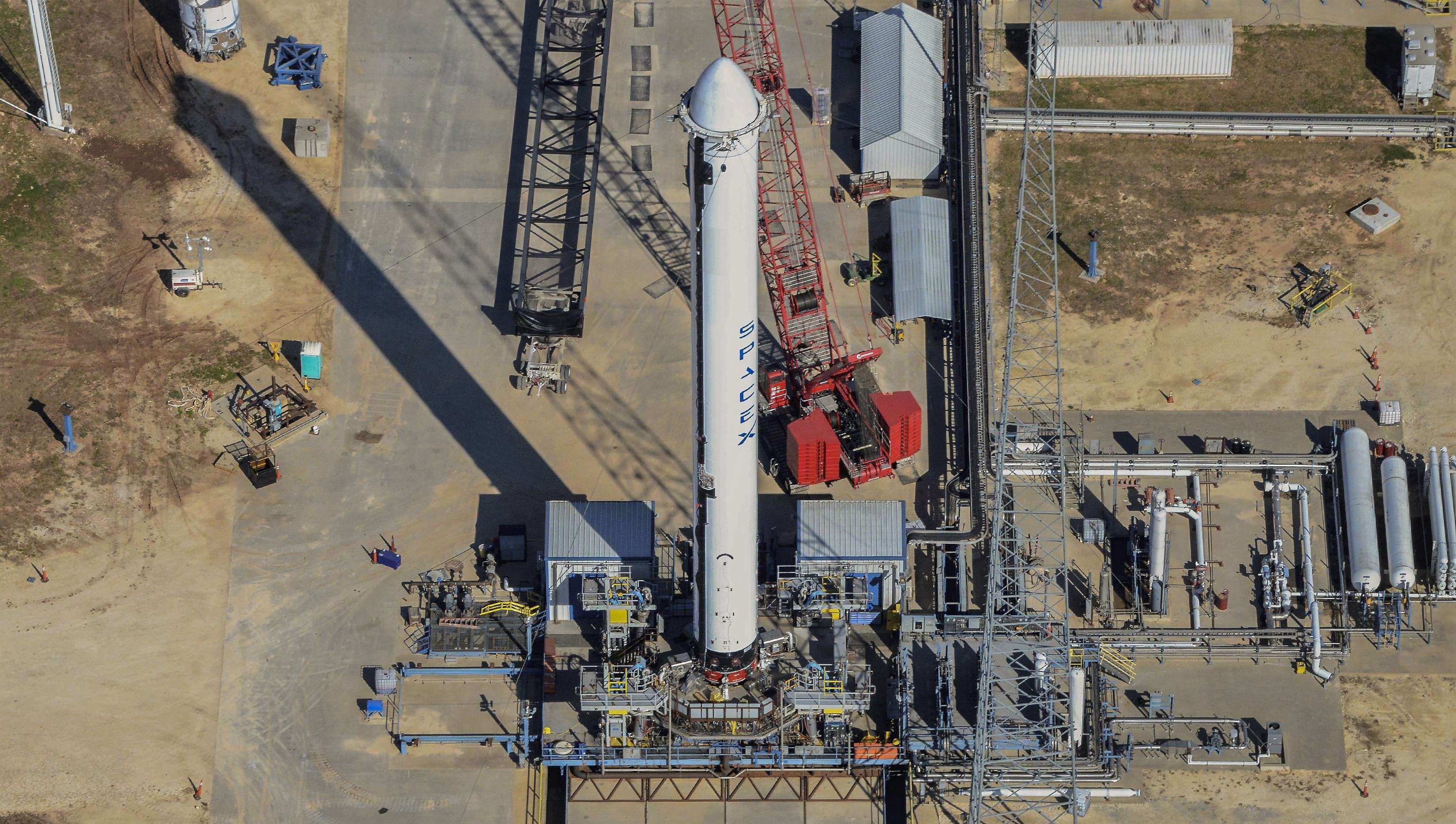
SpaceX’s first Falcon Heavy launch famously featured flight-proven side boosters that performed jaw-dropping simultaneous landings at LZ-1 and LZ-2. Chances are good that Falcon Heavy Flight 2 and 3 will both feature additional attempts at simultaneous LZ booster landings. If SpaceX can find a way to launch Falcon Heavy twice in barely two months while still reusing all three first stage boosters, it’s hard to imagine a better way to demonstrate the economic and technological viability of both Falcon Heavy and Block 5’s reusability upgrades.
For prompt updates, on-the-ground perspectives, and unique glimpses of SpaceX’s rocket recovery fleet check out our brand new LaunchPad and LandingZone newsletters!

News
Tesla FSD fleet is nearing 7 billion total miles, including 2.5 billion city miles
As can be seen on Tesla’s official FSD webpage, vehicles equipped with the system have now navigated over 6.99 billion miles.

Tesla’s Full Self-Driving (Supervised) fleet is closing in on almost 7 billion total miles driven, as per data posted by the company on its official FSD webpage.
These figures hint at the massive scale of data fueling Tesla’s rapid FSD improvements, which have been quite notable as of late.
FSD mileage milestones
As can be seen on Tesla’s official FSD webpage, vehicles equipped with the system have now navigated over 6.99 billion miles. Tesla owner and avid FSD tester Whole Mars Catalog also shared a screenshot indicating that from the nearly 7 billion miles traveled by the FSD fleet, more than 2.5 billion miles were driven inside cities.
City miles are particularly valuable for complex urban scenarios like unprotected turns, pedestrian interactions, and traffic lights. This is also the difference-maker for FSD, as only complex solutions, such as Waymo’s self-driving taxis, operate similarly on inner-city streets. And even then, incidents such as the San Francisco blackouts have proven challenging for sensor-rich vehicles like Waymos.
Tesla’s data edge
Tesla has a number of advantages in the autonomous vehicle sector, one of which is the size of its fleet and the number of vehicles training FSD on real-world roads. Tesla’s nearly 7 billion FSD miles then allow the company to roll out updates that make its vehicles behave like they are being driven by experienced drivers, even if they are operating on their own.
So notable are Tesla’s improvements to FSD that NVIDIA Director of Robotics Jim Fan, after experiencing FSD v14, noted that the system is the first AI that passes what he described as a “Physical Turing Test.”
“Despite knowing exactly how robot learning works, I still find it magical watching the steering wheel turn by itself. First it feels surreal, next it becomes routine. Then, like the smartphone, taking it away actively hurts. This is how humanity gets rewired and glued to god-like technologies,” Fan wrote in a post on X.
News
Tesla starts showing how FSD will change lives in Europe
Local officials tested the system on narrow country roads and were impressed by FSD’s smooth, human-like driving, with some calling the service a game-changer for everyday life in areas that are far from urban centers.

Tesla has launched Europe’s first public shuttle service using Full Self-Driving (Supervised) in the rural Eifelkreis Bitburg-Prüm region of Germany, demonstrating how the technology can restore independence and mobility for people who struggle with limited transport options.
Local officials tested the system on narrow country roads and were impressed by FSD’s smooth, human-like driving, with some calling the service a game-changer for everyday life in areas that are far from urban centers.
Officials see real impact on rural residents
Arzfeld Mayor Johannes Kuhl and District Administrator Andreas Kruppert personally tested the Tesla shuttle service. This allowed them to see just how well FSD navigated winding lanes and rural roads confidently. Kruppert said, “Autonomous driving sounds like science fiction to many, but we simply see here that it works totally well in rural regions too.” Kuhl, for his part, also noted that FSD “feels like a very experienced driver.”
The pilot complements the area’s “Citizen Bus” program, which provides on-demand rides for elderly residents who can no longer drive themselves. Tesla Europe shared a video of a demonstration of the service, highlighting how FSD gives people their freedom back, even in places where public transport is not as prevalent.
What the Ministry for Economic Affairs and Transport says
Rhineland-Palatinate’s Minister Daniela Schmitt supported the project, praising the collaboration that made this “first of its kind in Europe” possible. As per the ministry, the rural rollout for the service shows FSD’s potential beyond major cities, and it delivers tangible benefits like grocery runs, doctor visits, and social connections for isolated residents.
“Reliable and flexible mobility is especially vital in rural areas. With the launch of a shuttle service using self-driving vehicles (FSD supervised) by Tesla in the Eifelkreis Bitburg-Prüm, an innovative pilot project is now getting underway that complements local community bus services. It is the first project of its kind in Europe.
“The result is a real gain for rural mobility: greater accessibility, more flexibility and tangible benefits for everyday life. A strong signal for innovation, cooperation and future-oriented mobility beyond urban centers,” the ministry wrote in a LinkedIn post.
News
Tesla China quietly posts Robotaxi-related job listing
Tesla China is currently seeking a Low Voltage Electrical Engineer to work on circuit board design for the company’s autonomous vehicles.

Tesla has posted a new job listing in Shanghai explicitly tied to its Robotaxi program, fueling speculation that the company is preparing to launch its dedicated autonomous ride-hailing service in China.
As noted in the listing, Tesla China is currently seeking a Low Voltage Electrical Engineer to work on circuit board design for the company’s autonomous vehicles.
Robotaxi-specific role
The listing, which was shared on social media platform X by industry watcher @tslaming, suggested that Tesla China is looking to fill the role urgently. The job listing itself specifically mentions that the person hired for the role will be working on the Low Voltage Hardware team, which would design the circuit boards that would serve as the nervous system of the Robotaxi.
Key tasks for the role, as indicated in the job listing, include collaboration with PCB layout, firmware, mechanical, program management, and validation teams, among other responsibilities. The role is based in Shanghai.
China Robotaxi launch
China represents a massive potential market for robotaxis, with its dense urban centers and supportive policies in select cities. Tesla has limited permission to roll out FSD in the country, though despite this, its vehicles have been hailed as among the best in the market when it comes to autonomous features. So far, at least, it appears that China supports Tesla’s FSD and Robotaxi rollout.
This was hinted at in November, when Tesla brought the Cybercab to the 8th China International Import Expo (CIIE) in Shanghai, marking the first time that the autonomous two-seater was brought to the Asia-Pacific region. The vehicle, despite not having a release date in China, received a significant amount of interest among the event’s attendees.
